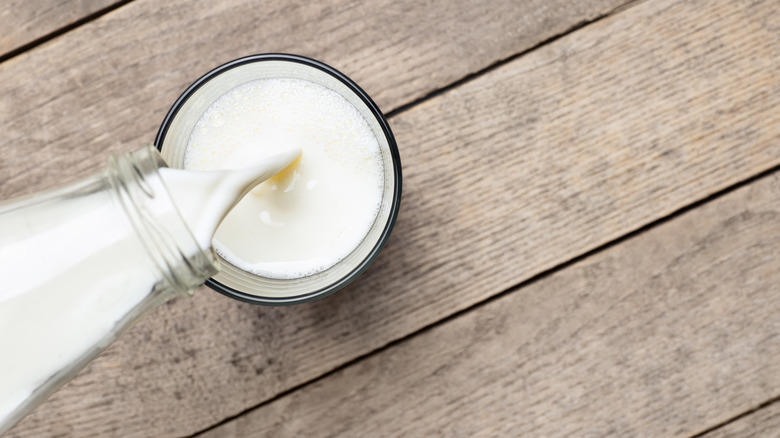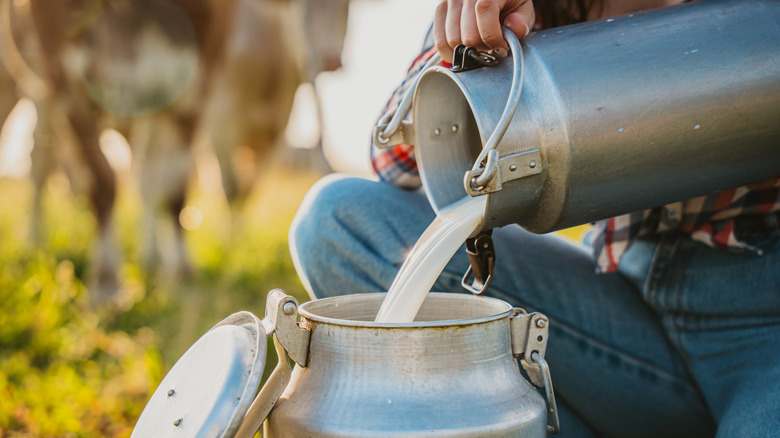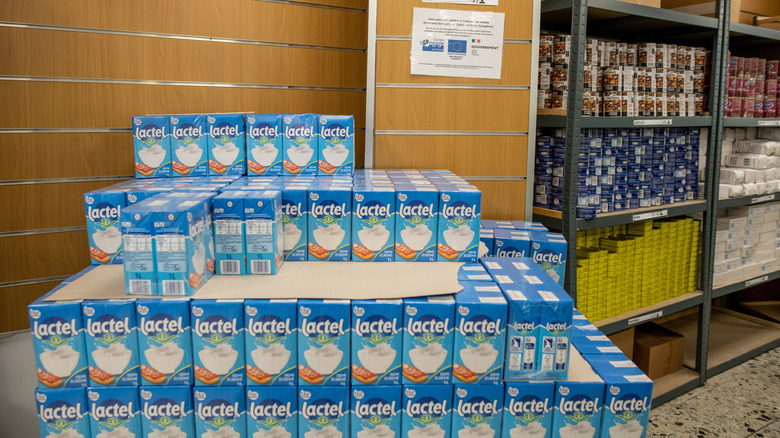Why Europeans Don't Refrigerate Their Milk
If an American were to walk into a Spanish grocery store, or a Spaniard were to walk into an American store, both would be surprised by one particular feature: The milk section. The American abroad would see bottles of milk out amongst the nonperishables, unrefrigerated, and might wonder how in the world one could safely drink such stuff. Meanwhile, the Spaniard would surely wonder why on Earth these Americans are wasting their refrigerator space on milk of all things. This hypothetical scenario would play out in just the same way if you were to replace the American with a Canadian, or the Spaniard with just about any European. That's because, while Americans and Canadians store milk in the refrigerator whether it's been opened or not, Europeans store unopened milk at room temperature.
To those of us in the Western Hemisphere, this can seem like a baffling and potentially dangerous move. Why would Europeans risk exposure to expired milk by not chilling it? Well, they're not actually risking anything as it turns out, because milk in Europe is different from milk in the U.S. and Canada. It has nothing to do with our respective species of cows, but rather with a process used in making nearly all commercially-sold milk — pasteurization. Pasteurized milk is the standard option no matter which continent you're on, but Europeans and Americans use two different methods to achieve it. This subtle change is the difference between milk that goes bad in a week and milk that lasts for months on end.
A brief history of pasteurized milk
Pasteurization uses heat to kill potentially dangerous bacteria in milk. You've probably heard that pasteurization was named after its inventor, French chemist Louis Pasteur, but this isn't exactly true. Pasteur never dealt with milk, and he didn't actually invent pasteurization at all. People knew that heat-treating foods made them safer for consumption long before Pasteur came around, but the Frenchman is credited with discovering just exactly why that was the case. He determined that food spoilage was caused by microorganisms, and that heat could kill them off. However, Pasteur implemented this knowledge not in the production of milk, but rather in the production of beer after the Franco-Prussian War in 1870. It wasn't until 1886 that German chemist Frans von Soxhlet decided to test the method on milk, changing the dairy business forever.
Before Soxhlet's innovation, milk could be a dangerous thing to drink. Drinking unpasteurized (aka raw) milk could expose you to multiple life-threatening diseases, including typhoid fever, scarlet fever, tuberculosis, diphtheria, and a wide array of diarrhea-inducing maladies that you don't even want to imagine. Understandably, the practice of pasteurizing milk caught on quickly, becoming mandatory in many parts of the world. Today, the sale of raw, unpasteurized milk is illegal in multiple states, so it's all but certain that the milk you drink on a regular basis has been pasteurized. However, there are two ways to pasteurize milk, and Europeans do it differently than Americans and Canadians do.
HTST pasteurization vs. UHT pasteurization
The two methods of pasteurizing milk are known as high temperature short time pasteurization (HTST) and ultra high-temperature pasteurization (UHT). For HTST, raw milk is heated to 161 degrees Fahrenheit for 15 seconds, then quickly cooled to 39 degrees Fahrenheit (right around the average temperature of a home refrigerator). HTST is the standard method in the United States and Canada, where it is preferred because it can handle larger batches of milk than UHT, which is the preferred method in Europe. UHT uses a higher temperature and shorter timeframe. The raw milk is heated all the way up to 284 degrees Fahrenheit (since UHT is used in Europe, we should note that this is equivalent to 140 degrees Celsius) for just about three seconds, then cooled.
HTST kills the most common bacterial baddies like salmonella and E. coli. However, it can leave some non-pathogenic bacteria alive. These bacteria won't cause disease, but they will still hasten spoilage, which is why HTST pasteurized milk always needs to stay in a refrigerator. UHT is performed at such a high temperature that no form of bacteria can survive it. UHT pasteurized milk can be kept at room temperature for three to six months unopened (it still needs refrigeration after opening). Why don't Americans and Canadians use UHT then? For starters, the higher temperature burns some of the sugars in milk, slightly changing its flavor. Furthermore, Americans have been conditioned to fear unrefrigerated milk, so when companies tried selling it in the U.S., they didn't have much success.


